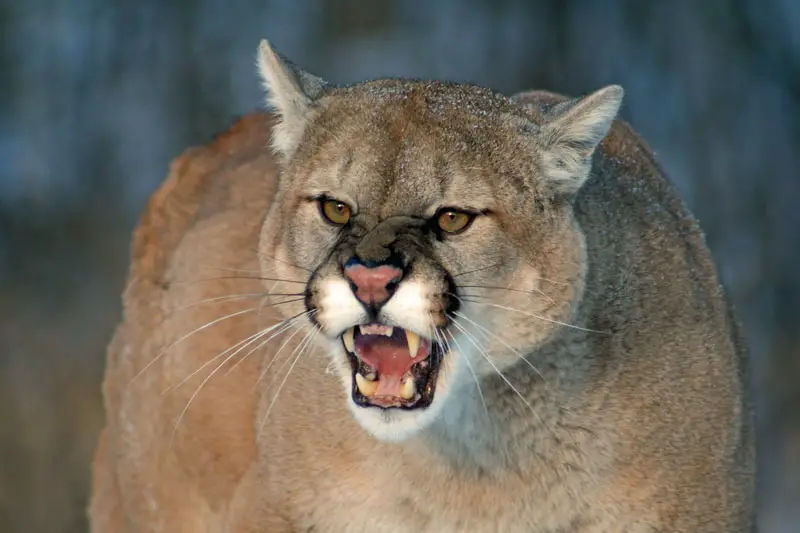The state of Michigan has 3 native wild cat species. These are the bobcat, the Canada lynx, and the mountain lion. Of these three, bobcats are the most abundant.
On the other hand, the Canada lynx, which is the bobcat’s close relative, exists in Michigan’s upper peninsula but is quite rare within the state.
Last but not least, mountain lions are native to Michigan. What’s more residents of Michigan report sightings of cougars in the state each year. However, according to the Michigan Department of Natural Resources, mountain lions have been extirpated from the state since the early 1900s. Until very recently, they’ve maintained that despite the confirmed accounts of cougar sightings within the state, there is no evidence of a breeding population of mountain lions in Michigan.
We’ll talk some more about these three feline predators in the paragraphs below.
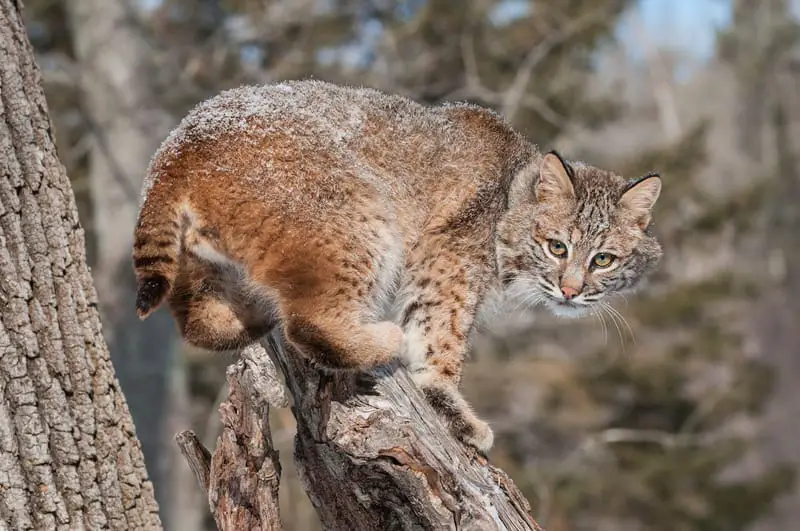
Bobcats in Michigan (Lynx rufus)
The American bobcat, which is also known as the red lynx, is a North American wild cat. Biologists believe that both the bobcat and the Canada lynx are descendants of the Eurasian lynx whose ancestors crossed into North America via the Bearing Sea land bridge.
Bobcats reside only in North America. Their range begins in Canada. Central British Columbia is the furthest north that bobcats live. Their range extends south through the United States and down into central Mexico. They are the most common wildcats in North America.
The bobcat population in Michigan has expanded to every county in the state. However, their population is the densest in the upper peninsula and the upper portion of the lower peninsula.
Bobcats are an elusive species of wild cat. They live in a variety of terrain. Look for them in broken habitat types that might include deciduous forests, pine forests, ravines, rocky ledges and/or outcroppings, and field borders.
The mottled black spots in the pattern of their fur give them excellent camouflage to live undetected in these environments.
Bobcats do not hibernate. They are active throughout the year. However, they’re rarely seen since they’re predominantly nocturnal or crepuscular animals. See
Bobcats are generally solitary animals. The exceptions to this generality are during mating season and when a female is raising young. They are territorial and have a home range that they patrol and post the boundaries of with claw-marked trees and scent markers of urine and feces.
Male bobcat home ranges are much larger than female bobcat home ranges. Additionally, a male bobcat’s home range may intersect the home ranges of several females.
What do bobcats look like?
A bobcat is much smaller than a mountain lion and slightly smaller than a Canada lynx. An average bobcat is about twice the size of a house cat.
An adult bobcat is 2 to 3 feet long and weighs about 15 to 35 pounds. A female bobcat is quite a bit smaller than a male.
These animals have black-tipped tails that are short or “bobbed,” with dark bands on their upper surface. Their tail also has a black tip on its upper surface but not the back. They generally have reddish-brown coats that can also trend to gray, with mottled dark spots that range from black to dark brown on their sides. Additionally, they have dark stripes on their inner forelegs and a white underbelly.
From a side view, you will notice that a bobcat is slightly higher at the rump than at the shoulders. Bobcats and lynx have long hind legs in proportion to their forelegs.
Bobcats have black-tufted ears. In other words, they have tufts of hair that poke up above their ears that are black at the tips. They do have shorter ear tufts than their close relative, the Canadian lynx.
The backs of their ears, below the black tips, are black. In the center of the black of each ear, they have a single white spot. This gives the impression of a false eye on the back of each ear.
They also have a whiskered face that seems broader due to the ruff of fur on their cheeks and their whiskers. Their eyes are yellow with round black pupils.
Bobcats aren’t adapted for deep snow.
Compared to Canada lynx, which thrive in deep snow country, bobcats struggle more in the snow due to the fact that they cannot walk on top of it like lynx can. A lynx’s large paws function like snowshoes keeping it on the snow’s surface. On the other hand, compared to lynx, bobcats have smaller paws that tend to sink into the snow. If the snow is too deep and powdery, it reduces their mobility along with their ability to catch prey.
This is why the bobcat range dies out in southern Canada; from there on north, Canada lynx are more prevalent and bobcats less so.
Bobcats are also unable to live at higher elevations as lynx do in the winter. In the winter, lynx are able to stay in the high country to hunt their preferred prey, snowshoe hares.

What do bobcats eat?
Despite their comparatively small size, bobcats are aggressive, tough predators. At times, particularly during the winter, they prey on animals that are much larger than they are, such as white-tail deer. However, deer are not their go-to prey.
They feed on a variety of wild animals, but studies done in Iowa showed that 95 percent of a bobcat’s diet consists of small prey such as rabbits, mice, voles, and squirrels. They are opportunistic feeders and might also feed on such animals as beavers, muskrats, porcupines, birds such as wild turkeys, reptiles, insects, and carrion. When they take up residence close to farming or urban areas, their menu might occasionally also include small agricultural animals, house pets, and feral cats.
Interestingly, they even prey on venomous snakes even though they are not immune to the venom. They accomplish this by using their quickness to pin the snake’s head down with a paw, after which they dispatch the snake with a quick bite to its spine behind the head.
In Michigan, the only venomous snake is the Eastern Massasauga.
Reproduction and life cycle for bobcats
Michigan bobcats mate in late winter. During the breeding season, a male bobcat may mate with multiple females. If they successfully mate, the gestation period for bobcats is 60 days. Females mostly give birth in early spring.
After breeding, the male and female go their separate ways. The female takes all responsibility for the selection of a den site and the rearing of the young.
Look for maternal dens in a wooded area. Bobcats use features such as a rock outcropping, hollow trees or hollow logs, openings in the ground, the root masses of overturned stumps, or the space beneath a fallen tree as denning sites.
A bobcat litter consists of anywhere from 1 to 5 kittens. The average litter size, though, is around 3. Bobcat kittens are born with their eyes sealed, just like domestic cats are. However, their eyes will open when they are a week to 10 days old. By the time they are 2 months old, they will have replaced their spotted baby fur with a haircoat similar to what their parents have.
By mid-July, the kittens begin to venture out with the mother bobcats to fine-tune their survival skills. Their training may last into the early winter. By mid-winter, the kittens strike out on their own.
Recent research done in Indiana by the Indiana Department of Natural Resources indicates that bobcats sometimes disperse up to 100 miles from where they were born. See
Female bobcats reach sexual maturity at 1 year of age, while males reach sexual maturity at age 2.
Bobcats live 12 to 15 years in the wild.
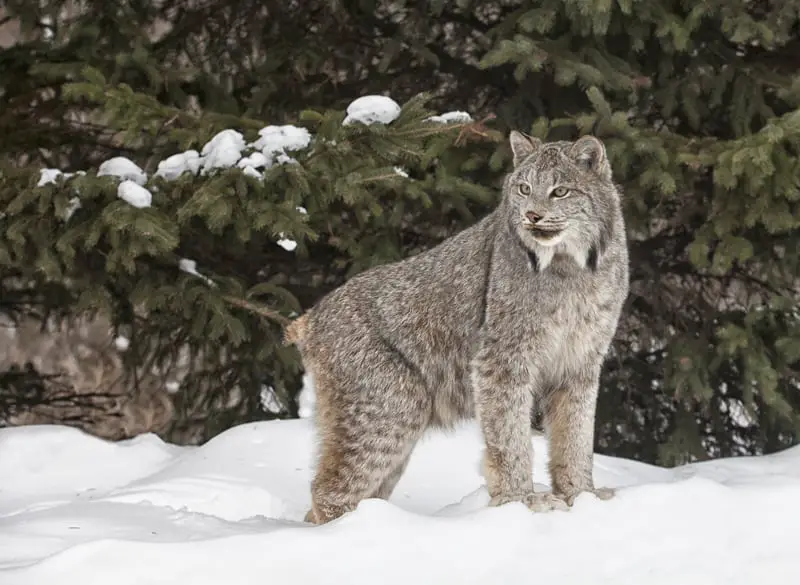
Canada lynx in Michigan (Lynx canadensis)
The Canada Lynx is sometimes also known as the Canadian Lynx. They are medium-sized wild cats that live in the boreal forest in the mountainous areas of Canada and the northern United States. They are 1 of 2 North American members of the “Lynx” genus. The other one is the bobcat.
The majority of the World’s Canada lynx population lives in the dense forests in the boreal regions of Canada, Alaska, and the northern contiguous United States.
In the United States, there are Canada lynx populations in Alaska. In the contiguous United States, there are lynx in the northern states of Maine, New Hampshire, Vermont, Minnesota, Montana, Idaho, and Washington. There are also lynx in Colorado and possibly Michigan, northeastern Utah, and northern New Mexico.
According to the Michigan State University Michigan Natural Features Inventory database, there have been 4 confirmed cases of Canada lynx in Michigan since 1979. One of these was in Keweenaw County in 1979, while 2 of them occurred in Mackinac County in 2003, and one occurred in Marquette County in 2022. All of these are on the upper peninsula of Michigan. See
The U.S Fish and Wildlife Service listed the Canada lynx in the contiguous United States as a threatened species under the Endangered Species Act in the year 2,000. Therefore, they are protected under federal law.
Canada Lynx Characteristics
What does a Canadian lynx look like? The Canadian Lynx closely resembles its close relative, the bobcat but with some differences. First of all, they are slightly larger than bobcats with longer legs. They are up to 35 1/2 inches (90 cm) long and 26 inches (65 cm) tall. Additionally, they weigh up to 37 and a half pounds (17 kg). While bobcats have “bobbed”, short tails, a lynx’s tail is shorter still.
Lynx don’t have the black bands on the topside of their tails that bobcats have. However, they do have black tips on the ends of their tails. One more difference is that the black tip on a lynx’s tail surrounds the entirety of the tail as if the tail had been dipped in black paint. On the other hand, the black tip is only on the top side of a bobcat’s tail.
Canada Lynx have long, thick grey fur in the winter. By summertime, they have shed their grey fur and have a thinner, shorter reddish brown hair coat instead. Their color is more uniform than that of bobcats. While bobcats have black spots and mottled coloration over their entire body, Lynx are solid tan except for some mottled darker brown spots on their legs.
Canadian Lynx have triangular pointed ears with black backs and long ear tufts of black hair on the tips. They have longer ear tufts than bobcats do. They also have drooping flared facial ruff of white hair on the sides of their face beneath their chin.
Their eyes are green with round black pupils.
Lynx have long legs in proportion to their bodies, with their hind legs being slightly longer than their front ones. This gives their body a peculiar, downhill-sloped appearance.
Canadian Lynx have almost comical-looking oversized furry feet. They put their larger feet to good use. Their large paws function like snowshoes, allowing them to travel and hunt on top of the snow. Canadian lynx feet can keep almost twice as much weight from sinking into the snow as those of a bobcat. This is why they range over the deep snow country of northern Canada while bobcats do not.
Canada lynx reproduction
Canada lynx mate in late winter. After that, the female’s gestation period lasts around 65 days, placing their parturition in early spring. She will give birth to from 1 to 5 kittens.
Kitten survivability varies with the abundance or lack thereof of snowshoe hares which are their main prey animal. In years when the population of snowshoe hares is low or average, few or no kittens survive, but when the hare population is high, lynx kitten survival is also very high.
Canada lynx kittens stay with their mother for one year before dispersing to their own home range.
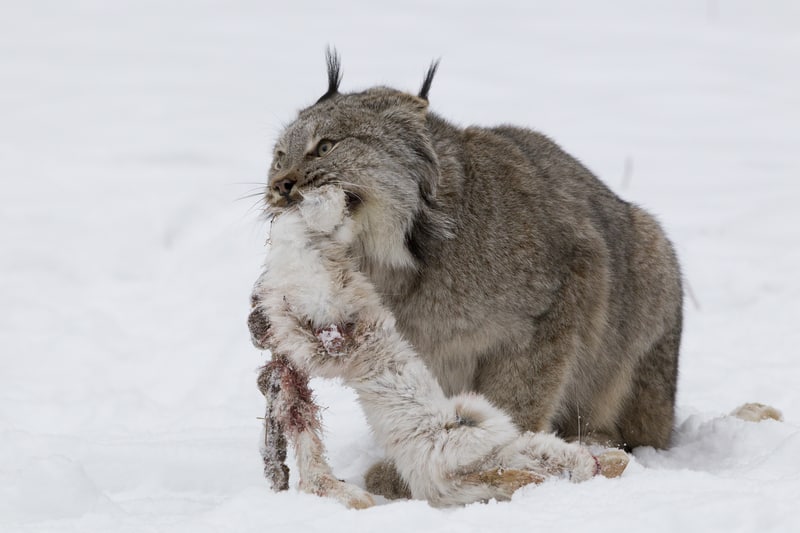
What do Canada Lynx eat?
Mice, squirrels, ptarmigan, grouse, ducks, deer, Dall sheep, and caribou make up a minor portion of a Canadian lynx’s diet in regions where these prey animals are available. However, over most of their range, their preferred food is Snowshoe hares.
Lynx and snowshoe hare
The Canada lynx is very dependent on snowshoe hares for a food source. In some areas, hares comprise 75 percent of their total diet. In fact, their population density is directly correlated with the snowshoe hare population.
Canadian and Alaskan Canadian Lynx and snowshoe hares go through what is known as the Lynx-Snowshoe Hare Cycle. When food sources are abundant for hares, their population increases very rapidly since they can have several litters per year. When hare populations are at their peak, there can be as many as 1500 animals per square kilometer, (3913 per square mile). At this time, the population of Lynx and other predators are also at their peaks.
In Minnesota, Canada lynx are chiefly dependent on snowshoe hares as prey animals. However, they also feed on deer, squirrels, various other small mammals, birds, and carrion.
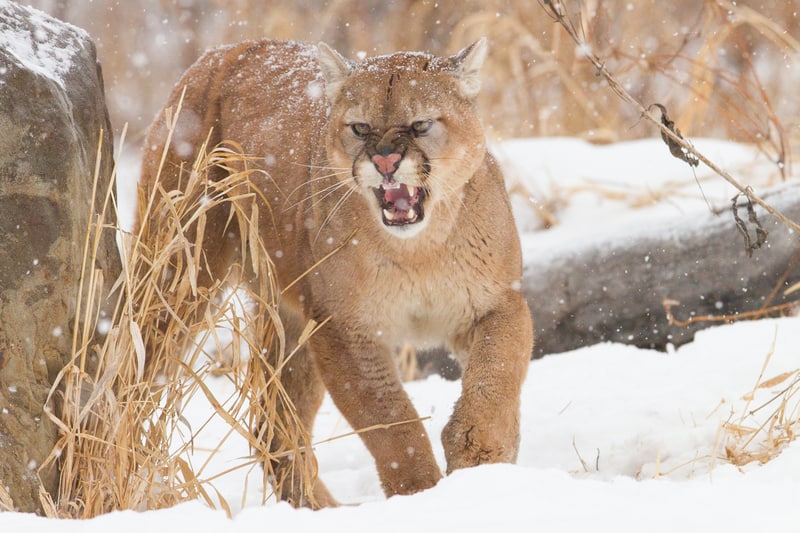
Mountain lions in Michigan (Puma concolor)
Due to the fact that they live in a wide geographical area, mountain lions have a long list of regional names. In recent years, their scientific name was even changed from Felis concolor to Puma concolor. Some common names that mountain lions go by are cougar, panther painter, Andean Mountain lion, and puma.
Where are mountain lions typically found?
Mountain lions live on all three of the American continents. Their range begins in Canada’s Yukon territory and extends south through parts of North America, Central America, and South America to the southern tip of Argentina.
In Canada, the biggest populations of them are in British Columbia and Alberta. On the other hand, in the United States, they mainly live in the western states, the two midwestern states of South Dakota and Nebraska, and Florida in the southeast. In Florida, the cougar is called the Florida Panther.
Although mountain lions are also native to most of the eastern and midwestern United States, they have been extirpated from most of this territory.
Mountain lions are native to Michigan, but due to overhunting and the loss of much of their habitat, they disappeared from the state in the early 1900s. According to the MDNR website, the last known wild cougar to be legally harvested in Michigan was in 1906. See
However, in recent years, confirmed reports of cougars in Michigan have been on the rise. From 2008 through 2021, the MDNR confirmed 76 cougar reports in 13 Michigan counties. One of these thirteen counties was on the lower peninsula The remaining 12 were on the upper.
Despite the upswing in mountain lion sightings within the state, the MDNR maintains that there is no scientific evidence of a breeding population of mountain lions within the state of Michigan.
“See the updated information on the evidence of breeding mountain lions in Michigan at the bottom of this section.”
They credit the cougar sightings within the state to young males that have wandered into Michigan from states that have established breeding populations.
Young male mountain lions sometimes travel long distances from established breeding populations as they attempt to establish their own territory free from dominant males.
A famous case of this occurred in 2011. In that instance, a young male cougar traveled all the way from South Dakota before he was struck and killed by a vehicle in Connecticut. See
“Update. Michigan wildlife officials confirmed that photos taken on March 6th in Ontonagon County, Michigan show a pair of mountain lion cubs. According to Michigan wildlife biologist and large carnivore specialist Brian Roell though, although the pictures offer evidence of cougar reproduction, they don’t offer evidence of a breeding population. Biologists can only assume the kittens were born in Michigan and there is not conclusive evidence as to where their mother was bred.”

What do mountain lions look like?
To visualize what a mountain lion looks like, picture a giant house cat with short, light brown fur. Mountain lions are much larger than domestic cats, though. Average house cats weigh in at around 10 pounds, while male mountain lions can weigh over 200 pounds.
These large cats have muscular slender bodies, rounded small heads, and upright ears that are oval at the tip. Another characteristic that mountain lions have is their muscular long tails, which account for almost one-third of the entire length of the animal. They use their long tail for a counterbalance, moving it from side to side as they navigate through uneven terrain.
Mountain lions have a tan coat of short, coarse hair over most of their body. The area around their nose, the tip of their tail, and the tips of their ears are black. Their belly, the area above their upper lip, below their lower lip, and their chin are all white. They also have a sprinkling of dark hair on their backs. There are some coat color variances depending on geographical location.
Mountain lions are the second largest cats in the Western hemisphere, smaller only than the Jaguar (Panthera onca). However, worldwide, the African Lion, ((Panthera leo) and the Tiger (Panthera tigris) are also larger.
Male and female mountain lions are phenotypically identical in every respect except for size. Males are 30 to 40% bigger than females. Though sizes vary considerably throughout the cat’s geographic range, an adult male typically weighs between 110 and 180 pounds, 50 to (82 kgs). A rare few of them grow bigger than 200 pounds (91kgs). Female mountain lions or queens average between 80 and 130 pounds (36 to 59 kgs). Adult males or toms will reach a length of 6 to 8 feet (1.8 to 2.4 M) from their snout to the tip of their tail. On the other hand, adult females are 5 to 7 feet long (1.5 to 2.1 M).
What do mountain lions eat?
Mountain lions are large predators that hunt alone from dark to morning, stalking their prey (mainly deer in the U.S. and Canada) from behind. On average, a lion kills a deer approximately once a week.
Additionally, they prey on most wild animals and domestic ones.
In Michigan, besides deer, this includes elk, feral horses, coyotes, raccoons, rats, feral hogs, porcupines, skunks, rabbits, various other small mammals, birds, reptiles, amphibians, livestock, pets, and just about any local wild animal they can catch.
A mountain lion may move its kill to a different location and cover it with dry leaves, grass, or pine needles to keep it safe from other animals. The big predator may return to the spot many days later to eat.
Large cats but not big cats
An interesting fact is that while an adult mountain lion might be a large cat or maybe even a big cat, they are not taxonomically classified as big cats because they cannot roar. A Snow leopard, for example, is smaller than a mountain lion. However, since snow leopards can roar and cannot purr, they are classified as big cats, while mountain lions are not. Another interesting thing that I can mention here is that mountain lions purr.
Since they purr and cannot roar, mountain lions are in the Felis genus, while big cats that cannot purr and can roar are in the Panthera genus.
Biologists taxonomically divided mountain lions into 2 sub-species in 2017. The first is (Puma concolor couguar) or northern cougar. Northern cougars range through North America, Central America, and possibly northwestern South America. The second sub-species is (Puma concolor concolor) or southern cougar. These cats range only in South America.
Recent Posts
The only venomous snakes in Washington State are Northern Pacific Rattlesnakes. The Northern Pacific Rattlesnake (Crotalus oreganus oreganus) is a sub-species of the Western Rattlesnake. Anyone...
Skunks are not classified as true hibernators. But they go into a state of torpor when the weather gets cold. Skunks are light sleep hibernators, along with opossums, bears, and raccoons. ...

